engine coolant SAAB 9-3 2009 User Guide
[x] Cancel search | Manufacturer: SAAB, Model Year: 2009, Model line: 9-3, Model: SAAB 9-3 2009Pages: 304, PDF Size: 44.31 MB
Page 201 of 304
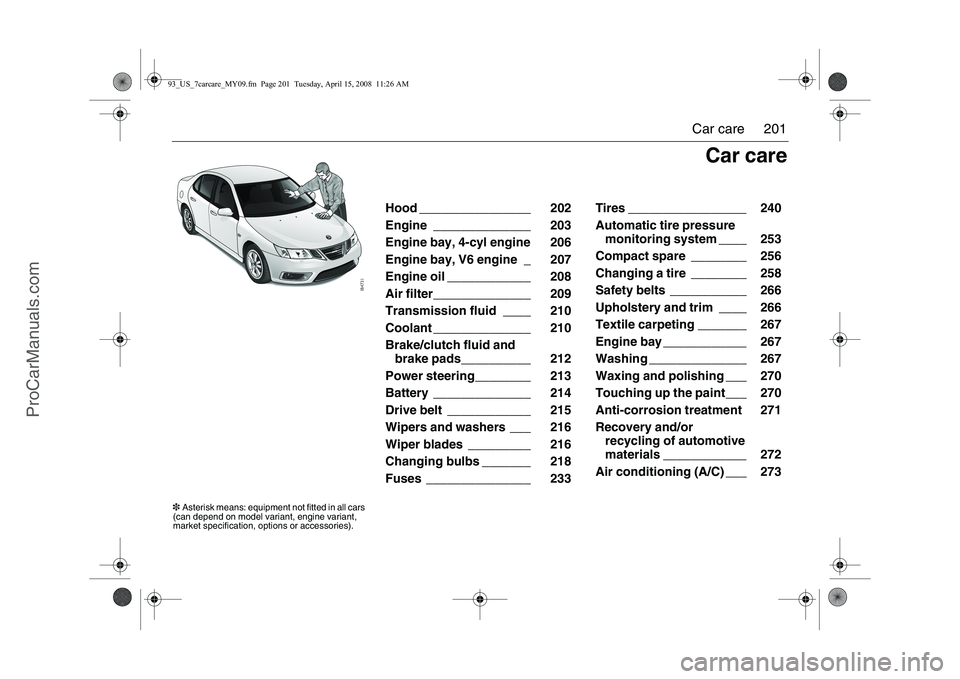
201
Car care
Hood ________________ 202
Engine ______________ 203
Engine bay, 4-cyl engine 206
Engine bay, V6 engine _ 207
Engine oil ____________ 208
Air filter______________ 209
Transmission fluid ____ 210
Coolant ______________ 210
Brake/clutch fluid and
brake pads__________ 212
Power steering________ 213
Battery ______________ 214
Drive belt ____________ 215
Wipers and washers ___ 216
Wiper blades _________ 216
Changing bulbs _______ 218
Fuses _______________ 233 Tires _________________ 240
Automatic tire pressure
monitoring system ____ 253
Compact spare ________ 256
Changing a tire ________ 258
Safety belts ___________ 266
Upholstery and trim ____ 266
Textile carpeting _______ 267
Engine bay ____________ 267
Washing ______________ 267
Waxing and polishing ___ 270
Touching up the paint___ 270
Anti-corrosion treatment 271
Recovery and/or recycling of automotive
materials ____________ 272
Air conditioning (A/C) ___ 273
Car care
3 Asterisk means: equipment not fitted in all cars
(can depend on model variant, engine variant,
market specification, options or accessories).93_US_7carcare_MY09.fm Page 201 Tuesday, April 15, 2008 11:26 AM
ProCarManuals.com
Page 204 of 304
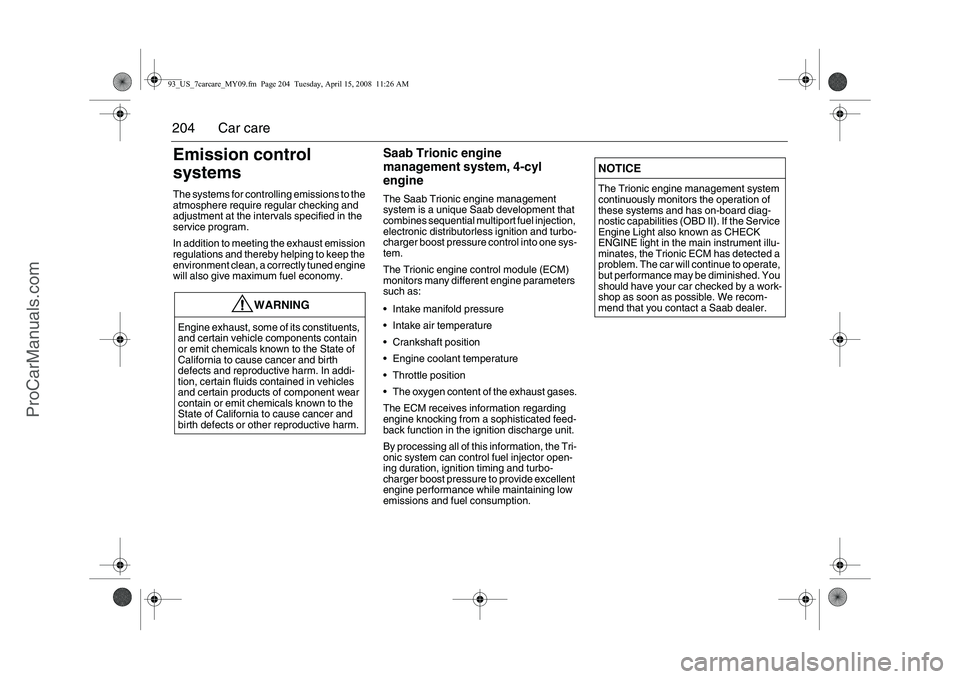
204 Car careEmission control
systemsThe systems for controlling emissions to the
atmosphere require regular checking and
adjustment at the intervals specified in the
service program.
In addition to meeting the exhaust emission
regulations and thereby helping to keep the
environment clean, a correctly tuned engine
will also give maximum fuel economy.
Saab Trionic engine
management system, 4-cyl
engineThe Saab Trionic engine management
system is a unique Saab development that
combines sequential mult iport fuel injection,
electronic distributorless ignition and turbo-
charger boost pressure control into one sys-
tem.
The Trionic engine control module (ECM)
monitors many different engine parameters
such as:
Intake manifold pressure
Intake air temperature
Crankshaft position
Engine coolant temperature
Throttle position
The oxygen content of the exhaust gases.
The ECM receives information regarding
engine knocking from a sophisticated feed-
back function in the ignition discharge unit.
By processing all of this information, the Tri-
onic system can control fuel injector open-
ing duration, ignition timing and turbo-
charger boost pressure to provide excellent
engine performance while maintaining low
emissions and fuel consumption.
WARNING
Engine exhaust, some of its constituents,
and certain vehicle components contain
or emit chemicals known to the State of
California to cause cancer and birth
defects and reproductive harm. In addi-
tion, certain fluids contained in vehicles
and certain products of component wear
contain or emit chemicals known to the
State of California to cause cancer and
birth defects or other reproductive harm.
NOTICEThe Trionic engine management system
continuously monitors the operation of
these systems and has on-board diag-
nostic capabilities (OBD II). If the Service
Engine Light also known as CHECK
ENGINE light in the main instrument illu-
minates, the Trionic ECM has detected a
problem. The car will continue to operate,
but performance may be diminished. You
should have your car checked by a work-
shop as soon as possible. We recom-
mend that you contact a Saab dealer.
93_US_7carcare_MY09.fm Page 204 Tuesday, April 15, 2008 11:26 AM
ProCarManuals.com
Page 205 of 304
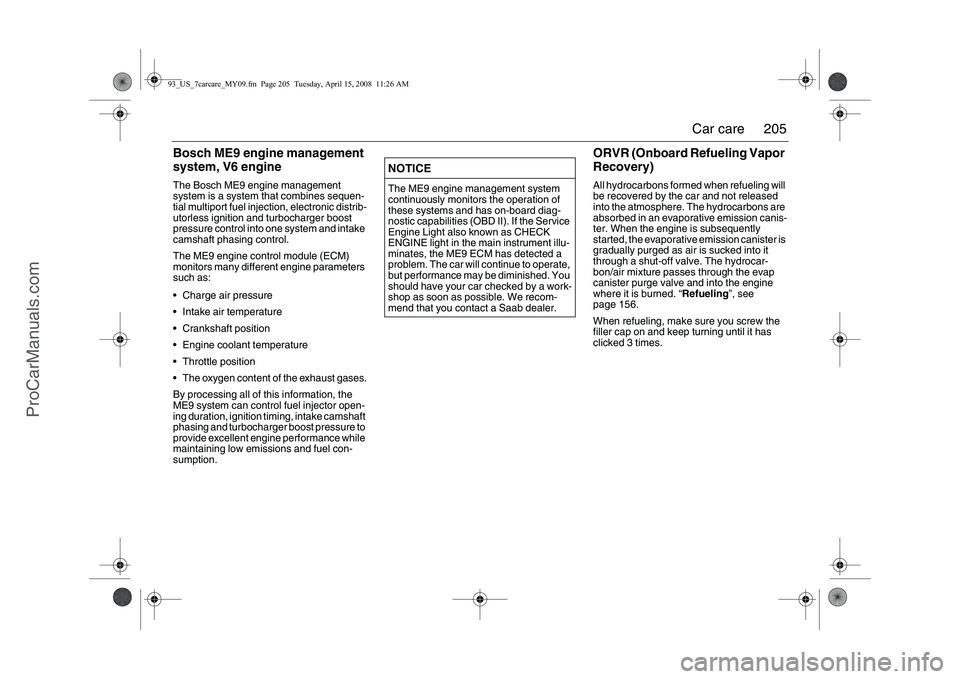
205
Car care
Bosch ME9 engine management
system, V6 engineThe Bosch ME9 engine management
system is a system that combines sequen-
tial multiport fuel injection, electronic distrib-
utorless ignition and turbocharger boost
pressure control into one system and intake
camshaft phasing control.
The ME9 engine control module (ECM)
monitors many different engine parameters
such as:
Charge air pressure
Intake air temperature
Crankshaft position
Engine coolant temperature
Throttle position
The oxygen content of the exhaust gases.
By processing all of this information, the
ME9 system can contro l fuel injector open-
ing duration, ignition timing, intake camshaft
phasing and turbocharger boost pressure to
provide excellent engine performance while
maintaining low emissions and fuel con-
sumption.
ORVR (Onboard Refueling Vapor
Recovery)All hydrocarbons formed when refueling will
be recovered by the car and not released
into the atmosphere. The hydrocarbons are
absorbed in an evaporative emission canis-
ter. When the engine is subsequently
started, the evaporative emission canister is
gradually purged as air is sucked into it
through a shut-off va lve. The hydrocar-
bon/air mixture passes through the evap
canister purge valve and into the engine
where it is burned. “ Refueling”, see
page 156.
When refueling, make sure you screw the
filler cap on and keep turning until it has
clicked 3 times.
NOTICEThe ME9 engine management system
continuously monitors the operation of
these systems and has on-board diag-
nostic capabilities (OBD II). If the Service
Engine Light also known as CHECK
ENGINE light in the main instrument illu-
minates, the ME9 ECM has detected a
problem. The car will continue to operate,
but performance may be diminished. You
should have your car checked by a work-
shop as soon as possible. We recom-
mend that you contact a Saab dealer.
93_US_7carcare_MY09.fm Page 205 Tuesday, April 15, 2008 11:26 AM
ProCarManuals.com
Page 206 of 304
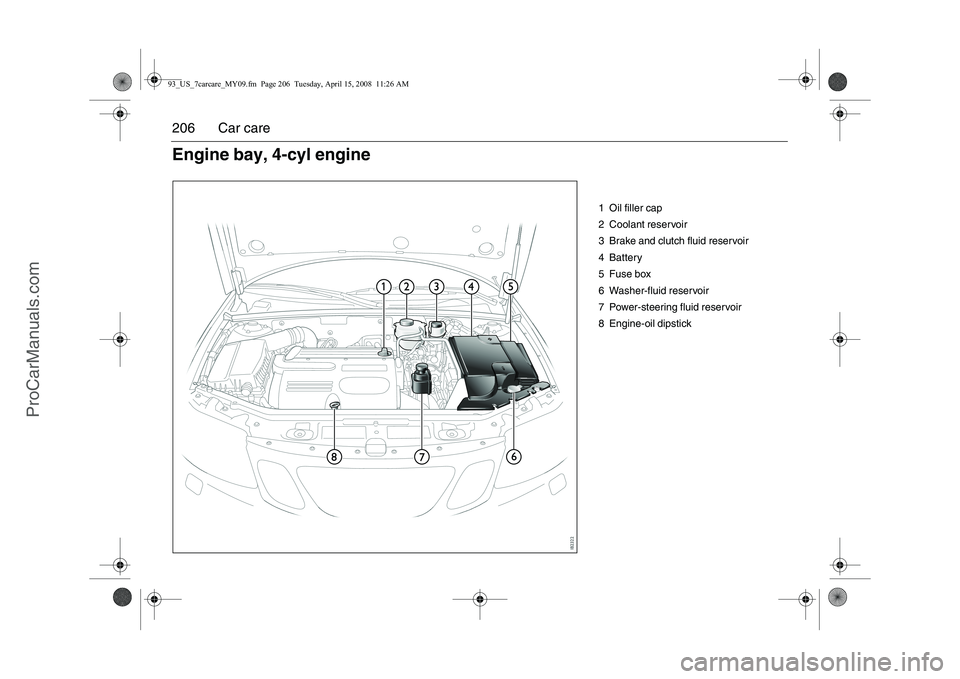
206 Car care
1 Oil filler cap
2 Coolant reservoir
3 Brake and clutch fluid reservoir
4Battery
5 Fuse box
6 Washer-fluid reservoir
7 Power-steering fluid reservoir
8 Engine-oil dipstick
Engine bay, 4-cyl engine93_US_7carcare_MY09.fm Page 206 Tuesday, April 15, 2008 11:26 AM
ProCarManuals.com
Page 207 of 304
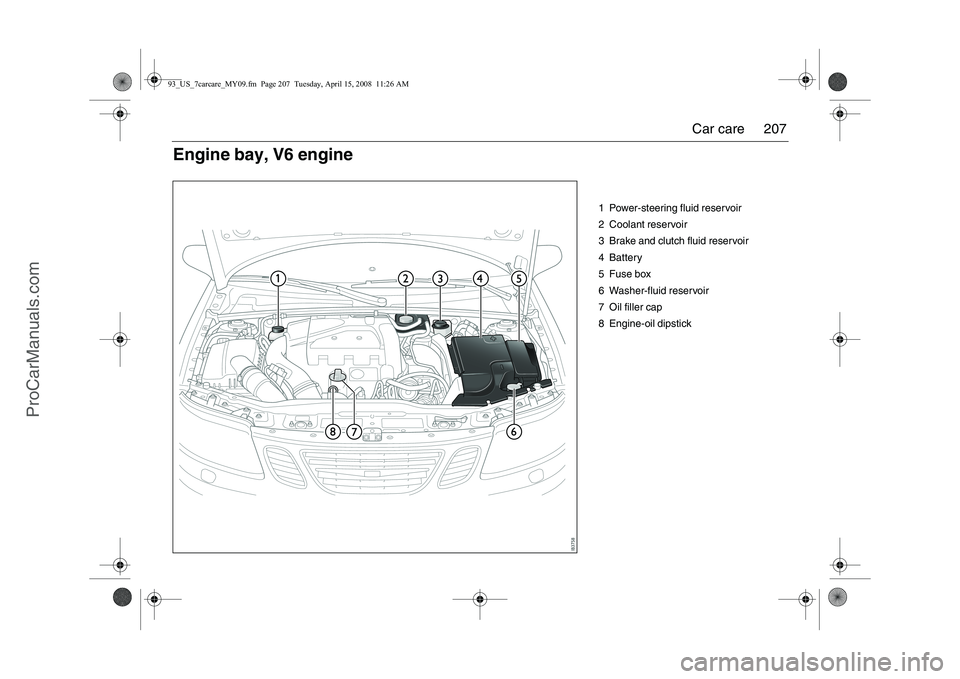
207
Car care
1 Power-steering fluid reservoir
2 Coolant reservoir
3 Brake and clutch fluid reservoir
4Battery
5 Fuse box
6 Washer-fluid reservoir
7 Oil filler cap
8 Engine-oil dipstick
Engine bay, V6 engine93_US_7carcare_MY09.fm Page 207 Tuesday, April 15, 2008 11:26 AM
ProCarManuals.com
Page 210 of 304
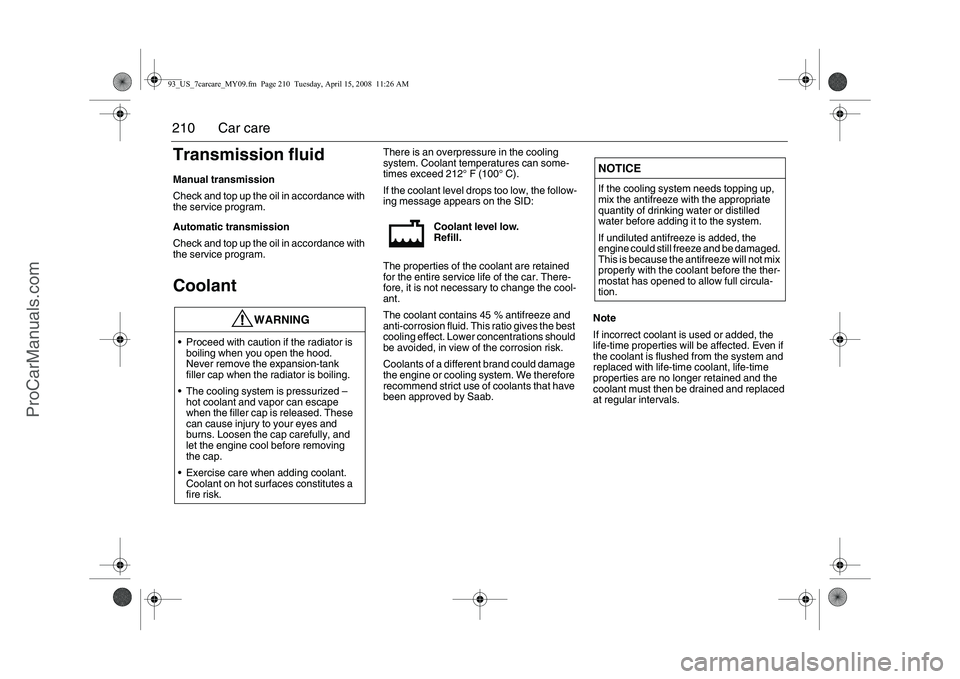
210 Car careTransmission fluidManual transmission
Check and top up the oil in accordance with
the service program.
Automatic transmission
Check and top up the oil in accordance with
the service program.Coolant
There is an overpressu re in the cooling
system. Coolant temper atures can some-
times exceed 212° F (100° C).
If the coolant level drops too low, the follow-
ing message appears on the SID:
The properties of the coolant are retained
for the entire service life of the car. There-
fore, it is not necessary to change the cool-
ant.
The coolant contains 45 % antifreeze and
anti-corrosion fluid. This ratio gives the best
cooling effect. Lower concentrations should
be avoided, in view of the corrosion risk.
Coolants of a different brand could damage
the engine or cooling system. We therefore
recommend strict use of coolants that have
been approved by Saab. Note
If incorrect coolant is used or added, the
life-time properties will be affected. Even if
the coolant is flushed from the system and
replaced with life-time coolant, life-time
properties are no longer retained and the
coolant must then be drained and replaced
at regular intervals.
WARNING
Proceed with caution if the radiator is
boiling when you open the hood.
Never remove the expansion-tank
filler cap when the radiator is boiling.
The cooling system is pressurized – hot coolant and vapor can escape
when the filler cap is released. These
can cause injury to your eyes and
burns. Loosen the cap carefully, and
let the engine cool before removing
the cap.
Exercise care when adding coolant. Coolant on hot surfaces constitutes a
fire risk.
Coolant level low.
Refill.
NOTICEIf the cooling system needs topping up,
mix the antifreeze with the appropriate
quantity of drinking water or distilled
water before adding it to the system.
If undiluted antifreeze is added, the
engine could still freeze and be damaged.
This is because the antifreeze will not mix
properly with the coolant before the ther-
mostat has opened to allow full circula-
tion.
93_US_7carcare_MY09.fm Page 210 Tuesday, April 15, 2008 11:26 AM
ProCarManuals.com
Page 211 of 304
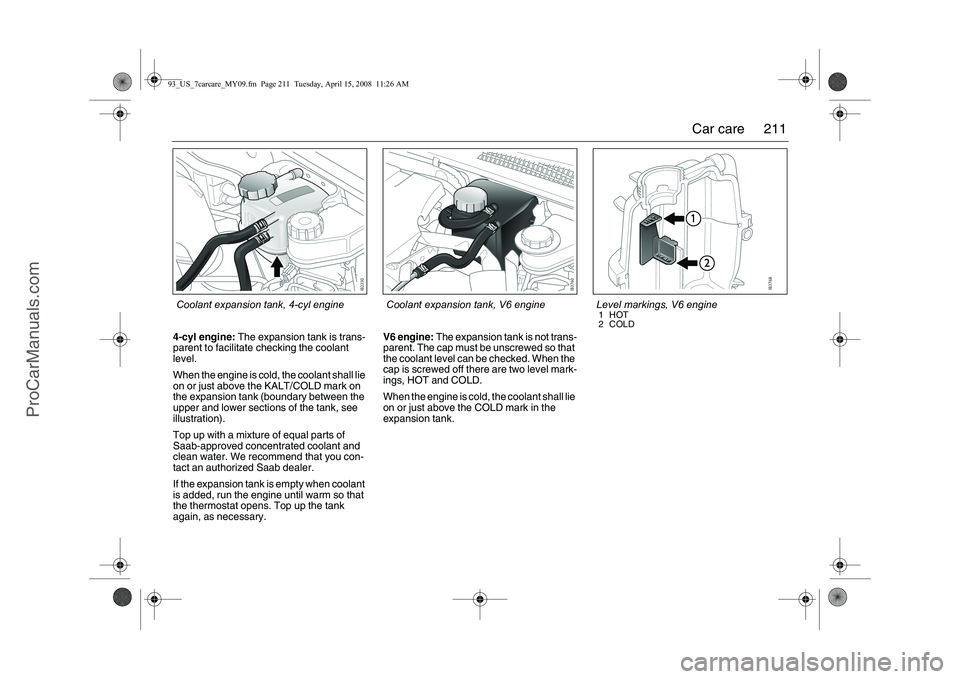
211
Car care
4-cyl engine: The expansion tank is trans-
parent to facilitate checking the coolant
level.
When the engine is cold, the coolant shall lie
on or just above the KALT/COLD mark on
the expansion tank (boundary between the
upper and lower sections of the tank, see
illustration).
Top up with a mixture of equal parts of
Saab-approved concentrated coolant and
clean water. We recommend that you con-
tact an authorized Saab dealer.
If the expansion tank is empty when coolant
is added, run the engine until warm so that
the thermostat opens. Top up the tank
again, as necessary. V6 engine:
The expansion tank is not trans-
parent. The cap must be unscrewed so that
the coolant level can be checked. When the
cap is screwed off there are two level mark-
ings, HOT and COLD.
When the engine is cold, the coolant shall lie
on or just above the COLD mark in the
expansion tank.
Coolant expansion tank, V6 engine Level markings, V6 engine
1HOT
2COLD
Coolant expansion tank, 4-cyl engine93_US_7carcare_MY09.fm Page 211 Tuesday, April 15, 2008 11:26 AM
ProCarManuals.com
Page 274 of 304

274 Car carecompressor uses a lubricant that circu-
lates with the coolant.
Note
The A/C system cannot be switched on
when the outside temperature is below 32°F
(0°C). Turn on the A/ C system when the car
is standing in a warm place. Simplest is to
always have the A/C button pressed in. The
A/C system will then cu t in automatically
when the outside temperature is high
enough.
Headlight aimingThe vehicle has a visual optical headlight
aiming system equippe d with vertical
aiming device. The aim has been preset at
the factory and should normally not need
further adjustments.
If your headlights are damaged in a crash,
the headlight aim may be affected. If you
believe your headlights need to be
re-aimed, we recommend that you take it to
your Saab dealer for service. However, it is
possible for you to re-aim your headlights as
described in the following procedure. To check the aim, the vehicle should be
properly prepared as follows:
The vehicle shall be placed so that the
headlights are 25 ft (7.6 m) from a light
colored wall or other flat surface. The
aiming area should be darkened, this will
improve your ability to see the beam of the
low beam headlight being aimed.
An optical headlamp aimer can also be
used and will than replace the wall.
The vehicle must have all four wheels on a perfectly level surface which is level all
the way to the wall or other flat surface.
The vehicle should be placed so it is perpendicular to the wall or other flat
surface.
The vehicle should be unloaded and fuel tank full, and one person or 160 lbs.
(75 kg) on the drivers seat.
The vehicle should be fully assembled and all other work stopped while headlight
aiming is being done.
The vehicle should not have any snow, ice or mud attached to it.
Tires should be inflated to the prescribed pressure.
Close all doors.
Rock the vehicle to stabilize the suspen- sion.
Headlight aiming is done with the vehicle
low beam lamps. The high beam lamps will
WARNING
Before checking/adjusting the headlight
aiming, switch off the engine to avoid
danger of fingers and hands being injured
by moving parts.
The radiator fan can start up even when
the engine is switched off.NOTICETo make sure that your headlights are
aimed properly read all instructions
before beginning. Failure to follow these
instructions could cause damage to
headlight parts or a not correctly aimed
headlight.
93_US_7carcare_MY09.fm Page 274 Tuesday, April 15, 2008 11:26 AM
ProCarManuals.com
Page 294 of 304
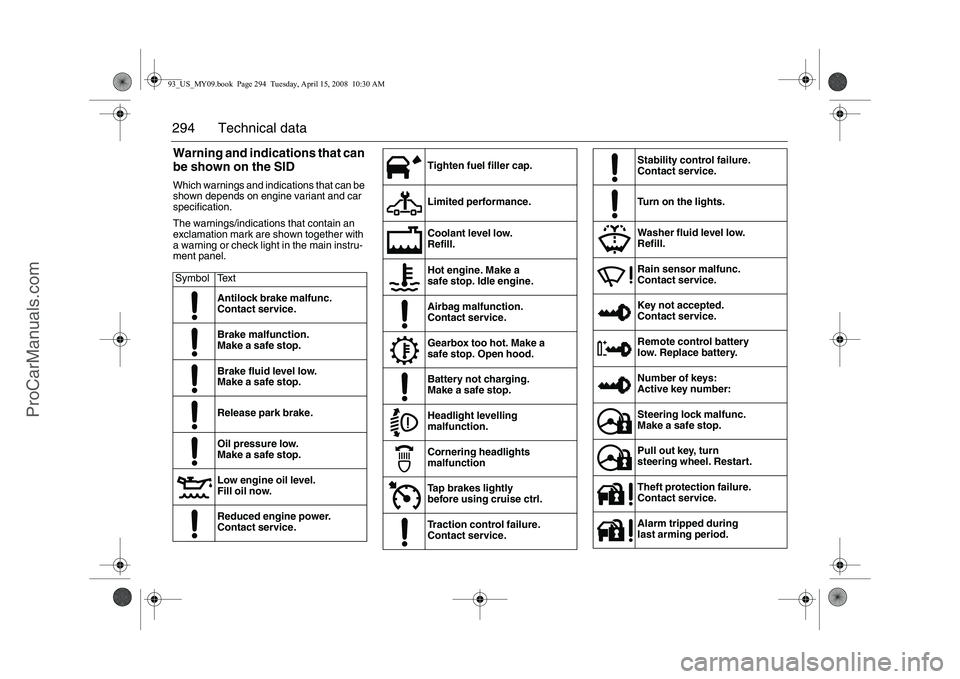
294 Technical dataWarning and indications that can
be shown on the SIDWhich warnings and indications that can be
shown depends on engine variant and car
specification.
The warnings/indications that contain an
exclamation mark are shown together with
a warning or check light in the main instru-
ment panel.
Symbol Text
Antilock brake malfunc.
Contact service.
Brake malfunction.
Make a safe stop.
Brake fluid level low.
Make a safe stop.
Release park brake.
Oil pressure low.
Make a safe stop.
Low engine oil level.
Fill oil now.
Reduced engine power.
Contact service.
Tighten fuel filler cap.
Limited performance.
Coolant level low.
Refill.
Hot engine. Make a
safe stop. Idle engine.
Airbag malfunction.
Contact service.
Gearbox too hot. Make a
safe stop. Open hood.
Battery not charging.
Make a safe stop.
Headlight levelling
malfunction.
Cornering headlights
malfunction
Tap brakes lightly
before using cruise ctrl.
Traction control failure.
Contact service.
Stability control failure.
Contact service.
Turn on the lights.
Washer fluid level low.
Refill.
Rain sensor malfunc.
Contact service.
Key not accepted.
Contact service.
Remote control battery
low. Replace battery.
Number of keys:
Active key number:
Steering lock malfunc.
Make a safe stop.
Pull out key, turn
steering wheel. Restart.
Theft protection failure.
Contact service.
Alarm tripped during
last arming period.
93_US_MY09.book Page 294 Tuesday, April 15, 2008 10:30 AM
ProCarManuals.com
Page 297 of 304
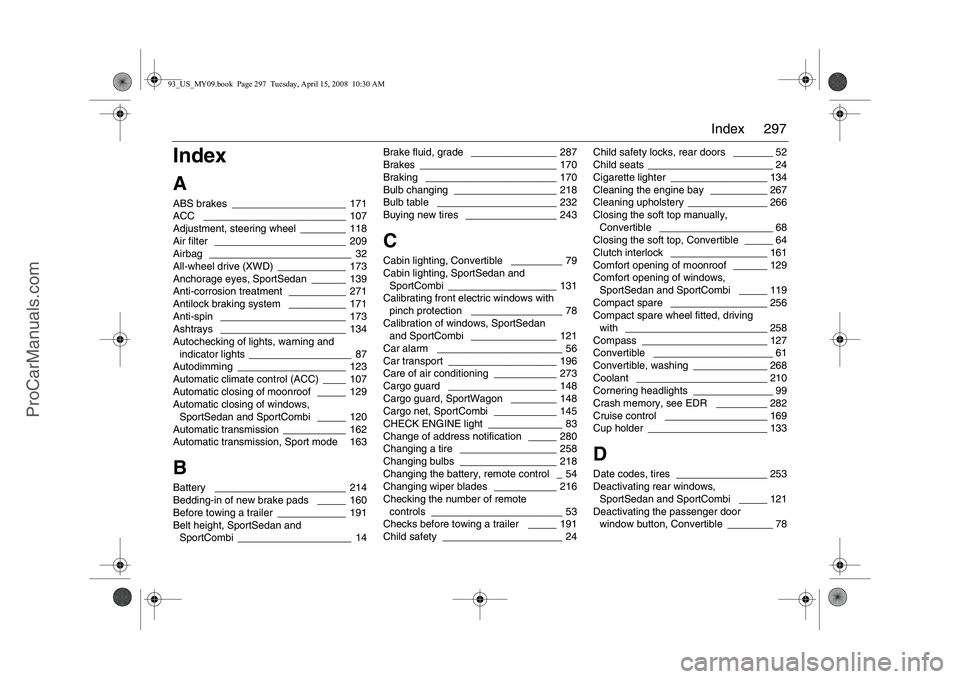
297 Index
IndexAABS brakes
____________________ 171
ACC
_________________________ 107
Adjustment, steering wheel
________ 118
Air filter
_______________________ 209
Airbag
_________________________ 32
All-wheel drive (XWD)
____________ 173
Anchorage eyes, SportSedan
______ 139
Anti-corrosion treatment
__________ 271
Antilock braking system __________ 171
Anti-spin
______________________ 173
Ashtrays ______________________ 134
Autochecking of lights, warning and
indicator lights
__________________ 87
Autodimming
___________________ 123
Automatic climate control (ACC)
____ 107
Automatic closing of moonroof
_____ 129
Automatic closing of windows,
SportSedan and SportCombi _____ 120
Automatic transmission
___________ 162
Automatic transmission, Sport mode
163
BBattery
_______________________ 214
Bedding-in of new brake pads
_____ 160
Before towing a trailer
____________ 191
Belt height, SportSedan and
SportCombi
____________________ 14Brake fluid, grade
_______________ 287
Brakes
________________________ 170
Braking _______________________ 170
Bulb changing
__________________ 218
Bulb table
_____________________ 232
Buying new tires
________________ 243
CCabin lighting, Convertible
_________ 79
Cabin lighting, SportSedan and
SportCombi
___________________ 131
Calibrating front electric windows with
pinch protection
________________ 78
Calibration of windows, SportSedan
and SportCombi _______________ 121
Car alarm
______________________ 56
Car transport ___________________ 196
Care of air conditioning
___________ 273
Cargo guard
___________________ 148
Cargo guard, SportWagon
________ 148
Cargo net, SportCombi
___________ 145
CHECK ENGINE light _____________ 83
Change of address notification
_____ 280
Changing a tire
_________________ 258
Changing bulbs _________________ 218
Changing the battery, remote control
_54
Changing wiper blades
___________ 216
Checking the number of remote
controls
_______________________ 53
Checks before towing a trailer
_____ 191
Child safety
_____________________ 24Child safety locks, rear doors
_______ 52
Child seats
______________________ 24
Cigarette lighter
_________________ 134
Cleaning the engine bay
__________ 267
Cleaning upholstery
______________ 266
Closing the soft top manually,
Convertible
____________________ 68
Closing the soft top, Convertible
_____ 64
Clutch interlock
_________________ 161
Comfort opening of moonroof
______ 129
Comfort opening of windows,
SportSedan and SportCombi _____ 119
Compact spare
_________________ 256
Compact spare wheel fitted, driving
with
_________________________ 258
Compass
______________________ 127
Convertible _____________________ 61
Convertible, washing
_____________ 268
Coolant
_______________________ 210
Cornering headlights
______________ 99
Crash memory, see EDR
_________ 282
Cruise control
__________________ 169
Cup holder
_____________________ 133
DDate codes, tires
________________ 253
Deactivating rear windows,
SportSedan and SportCombi
_____ 121
Deactivating the passenger door
window button, Convertible
________ 78
93_US_MY09.book Page 297 Tuesday, April 15, 2008 10:30 AM
ProCarManuals.com